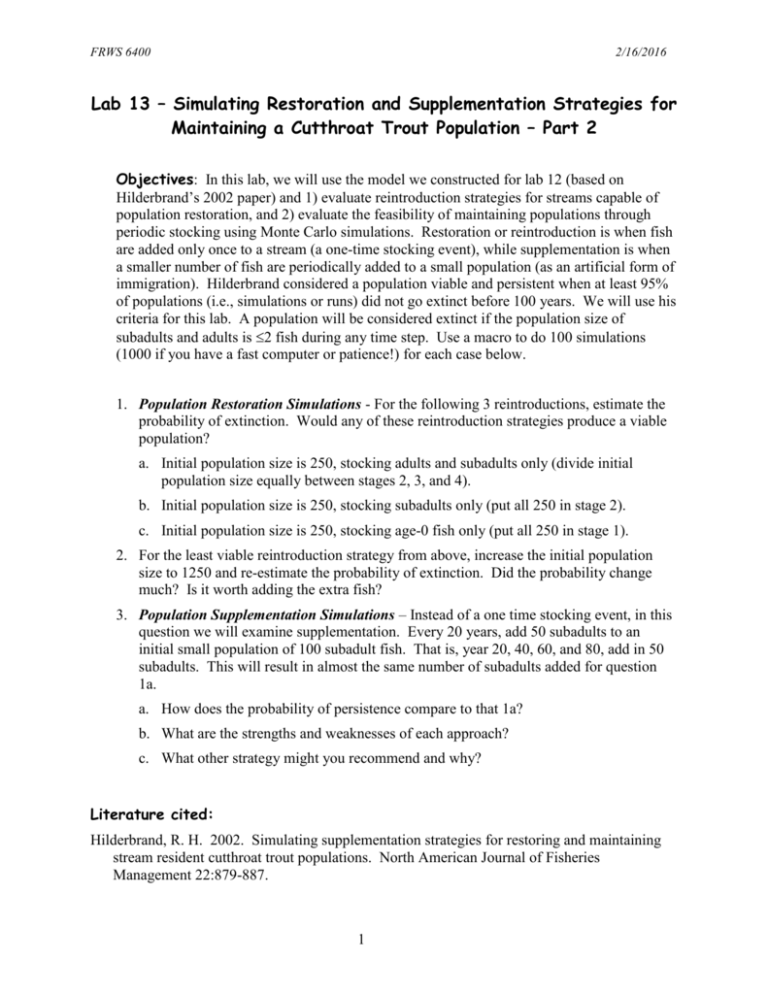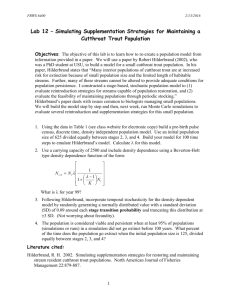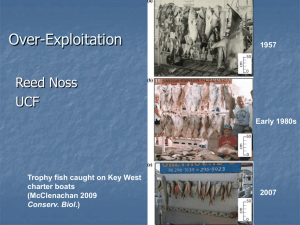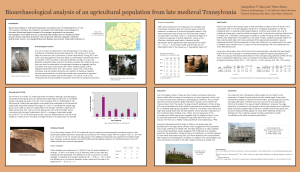Lab 5 – Density Independent Population Growth
advertisement

FRWS 6400
2/16/2016
Lab 13 – Simulating Restoration and Supplementation Strategies for
Maintaining a Cutthroat Trout Population – Part 2
Objectives: In this lab, we will use the model we constructed for lab 12 (based on
Hilderbrand’s 2002 paper) and 1) evaluate reintroduction strategies for streams capable of
population restoration, and 2) evaluate the feasibility of maintaining populations through
periodic stocking using Monte Carlo simulations. Restoration or reintroduction is when fish
are added only once to a stream (a one-time stocking event), while supplementation is when
a smaller number of fish are periodically added to a small population (as an artificial form of
immigration). Hilderbrand considered a population viable and persistent when at least 95%
of populations (i.e., simulations or runs) did not go extinct before 100 years. We will use his
criteria for this lab. A population will be considered extinct if the population size of
subadults and adults is 2 fish during any time step. Use a macro to do 100 simulations
(1000 if you have a fast computer or patience!) for each case below.
1. Population Restoration Simulations - For the following 3 reintroductions, estimate the
probability of extinction. Would any of these reintroduction strategies produce a viable
population?
a. Initial population size is 250, stocking adults and subadults only (divide initial
population size equally between stages 2, 3, and 4).
b. Initial population size is 250, stocking subadults only (put all 250 in stage 2).
c. Initial population size is 250, stocking age-0 fish only (put all 250 in stage 1).
2. For the least viable reintroduction strategy from above, increase the initial population
size to 1250 and re-estimate the probability of extinction. Did the probability change
much? Is it worth adding the extra fish?
3. Population Supplementation Simulations – Instead of a one time stocking event, in this
question we will examine supplementation. Every 20 years, add 50 subadults to an
initial small population of 100 subadult fish. That is, year 20, 40, 60, and 80, add in 50
subadults. This will result in almost the same number of subadults added for question
1a.
a. How does the probability of persistence compare to that 1a?
b. What are the strengths and weaknesses of each approach?
c. What other strategy might you recommend and why?
Literature cited:
Hilderbrand, R. H. 2002. Simulating supplementation strategies for restoring and maintaining
stream resident cutthroat trout populations. North American Journal of Fisheries
Management 22:879-887.
1
FRWS 6400
2/16/2016
Functions and formulas you will use for this lab:
N(t+1) = N(t) + B(t) – D(t) to incorporate demographic stochasticity
N(t+1) = N(t)(1 + b – d) to incorporate temporal stochasticity
CRITBINOM(trials,probability_s,alpha) – demographic stochasticity
BETAINV(probability,alpha,beta,A,B) – temporal stochasticity
(
=IF TRIM (ISERR ( MIN(E14:E43) ) ) ="TRUE", "", MIN(E14:E43)
)
=COUNTIF(F14:F43,">0")-1 – to calculate years to crash
COUNTIF(range,criteria)
Range is the range of cells from which you want to count cells.
Criteria is the criteria in the form of a number, expression, or text that defines which cells will
be counted. For example, criteria can be expressed as 32, "32", ">32", "apples".
{=FREQUENCY(B12:B1011,$F$12:$F$18)}
FREQUENCY(data_array,bins_array)
Note The formula in the example must be entered as an array formula. After copying the
example to a blank worksheet, select the range A13:A16 starting with the formula cell. Press F2,
and then press CTRL+SHIFT+ENTER
=IF($B11<=C$9,0,1) – for time to crash calculations
=SUM(C11:C1010)/COUNT(C11:C1010) – to calculate probabilities
=ROUND(E15*S_doe,0)
ROUND (number or function, #digits)
2








